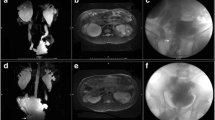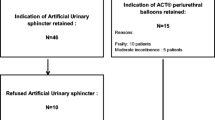Abstract
Purpose
Patients with artificial urinary eventually need surgical revision. Unfortunately, in women, this requires another invasive abdominal intervention. Robotic-assisted revision may provide a less invasive and more acceptable approach for sphincter revision in women. We wanted to determinate the continence status after robotic-assisted artificial urinary sphincter revision among women with stress incontinence. We also examined postoperative complications and the safety of the procedure.
Methods
The chart of the 31 women with stress urinary incontinence who underwent robotic-assisted AUS revision at our referral center from January 2015 to January 2022 were reviewed retrospectively. All patients underwent a robotic-assisted artificial urinary sphincter revision by one of our two expert surgeons. The primary outcome was to determinate the continence rate after revision and the secondary outcome aimed to evaluate the safety and feasibility of the procedure.
Results
Mean patients age was 65 years old, and the mean time between the sphincter revision and previous implantation was 98 months. After a mean follow-up of 35 months, 75% of the patients were fully continent (0-pad). Moreover, 71% of the women were back to the same continence status as with the previously functional sphincter, while 14% even have an improved continence status. Clavien–Dindo grade \(\ge \) 3 and overall complications occurred in 9% and 20.5% of our patients, respectively. This study is mainly limited by its retrospective design.
Conclusion
Robotic-assisted AUS revision carries satisfying outcome in terms of continence and safety.
Similar content being viewed by others
References
Hampel C, Artibani W, Espuna Pons M, Haab F, Jackson S, Romero J, Gavart S, Papanicolaou S (2004) Understanding the burden of stress urinary incontinence in Europe: a qualitative review of the literature. Eur Urol 46(1):15–27. https://doi.org/10.1016/j.eururo.2004.02.003
Coyne KS, Kvasz M, Ireland AM, Milsom I, Kopp ZS, Chapple CR (2012) Urinary incontinence and its relationship to mental health and health-related quality of life in men and women in Sweden, the United Kingdom, and the United States. Eur Urol 61(1):88–95. https://doi.org/10.1016/j.eururo.2011.07.049
Subak LL, Goode PS, Brubaker L, Kusek JW, Schembri M, Lukacz ES, Kraus SR, Chai TC, Norton P, Tennstedt SL (2014) Urinary incontinence management costs are reduced following Burch or sling surgery for stress incontinence. Am J Obstet Gynecol 211(2):171–177. https://doi.org/10.1016/j.ajog.2014.03.012
Costa P, Mottet N, Rabut B, Thuret R, Ben Naoum K, Wagner L (2001) The use of an artificial urinary sphincter in women with type III incontinence and a negative Marshall test. J Urol 165(4):1172–1176. https://www.ncbi.nlm.nih.gov/pubmed/11257664
Nambiar AK, Arlandis S, Bo K, Cobussen-Boekhorst H, Costantini E, de Heide M, Farag F, Groen J, Karavitakis M, Lapitan MC, Manso M, Arteaga SM, Riogh ANA, O’Connor E, Omar MI, Peyronnet B, Phe V, Sakalis VI, Sihra N, Harding CK (2022) European Association of urology guidelines on the diagnosis and management of female non-neurogenic lower urinary tract symptoms. Part 1: diagnostics, overactive bladder, stress urinary incontinence, and mixed urinary incontinence. Eur Urol. https://doi.org/10.1016/j.eururo.2022.01.045
Peyronnet B, Greenwell T, Gray G, Khavari R, Thiruchelvam N, Capon G, Ockrim J, Lopez-Fando L, Gilleran J, Fournier G, Van Koeveringe GA, Van Der Aa F (2020) Current use of the artificial urinary sphincter in adult females. Curr Urol Rep 21(12):53. https://doi.org/10.1007/s11934-020-01001-1
Fournier G, Callerot P, Thoulouzan M, Valeri A, Perrouin-Verbe MA (2014) Robotic-assisted laparoscopic implantation of artificial urinary sphincter in women with intrinsic sphincter deficiency incontinence: initial results. Urology 84(5):1094–1098. https://doi.org/10.1016/j.urology.2014.07.013
Gondran-Tellier B, Boissier R, Baboudjian M, Rouy M, Gaillet S, Lechevallier E, Michel F, Karsenty G (2019) Robot-assisted implantation of an artificial urinary sphincter, the AMS-800, via a posterior approach to the bladder neck in women with intrinsic sphincter deficiency. BJU Int 124(6):1077–1080. https://doi.org/10.1111/bju.14884
Peyronnet B, Gray G, Capon G, Cornu JN, Van Der Aa F (2021) Robot-assisted artificial urinary sphincter implantation. Curr Opin Urol 31(1):2–10. https://doi.org/10.1097/MOU.0000000000000837
Biardeau X, Rizk J, Marcelli F, Flamand V (2015) Robot-assisted laparoscopic approach for artificial urinary sphincter implantation in 11 women with urinary stress incontinence: surgical technique and initial experience. Eur Urol 67(5):937–942. https://doi.org/10.1016/j.eururo.2014.12.041
Kourbanhoussen K, Cecchi M, Chevrot A, Costa P, Droupy S, Wagner L (2019) Laparoscopic robot-assisted artificial urinary sphincter in women: first approach. Prog Urol 29(7):371–377. https://doi.org/10.1016/j.purol.2019.03.002
Peyronnet B, Vincendeau S, Tondut L, Bensalah K, Damphousse M, Manunta A (2016) Artificial urinary sphincter implantation in women with stress urinary incontinence: preliminary comparison of robot-assisted and open approaches. Int Urogynecol J 27(3):475–481. https://doi.org/10.1007/s00192-015-2858-7
Chartier-Kastler E, Vaessen C, Roupret M, Bassi S, Cancrini F, Phe V (2020) Robot-assisted laparoscopic artificial urinary sphincter insertion in women with stress urinary incontinence: a pilot single-centre study. BJU Int 126(6):722–730. https://doi.org/10.1111/bju.15147
Funding
This research received no specific grant from any funding agency in the public, commercial, or not-for-profit sectors.
Author information
Authors and Affiliations
Contributions
AB protocol and project development, data collection, data analysis, manuscript writing. CV project development, manuscript editing. PM project development, manuscript editing. MBP manuscript editing. XR manuscript editing. EC-K project development, manuscript editing.
Corresponding author
Ethics declarations
Conflict of interest
Pr. Emmanuel Chartier-Kastler: consultant/investigator at Boston Scientific, Medtronic, Promedon, Uromems, Coloplast, Convatec, BBraun, Wellspect, Uromedica.
Informed consent
All patients gave their written consent at time of hospitalisation for collection of data and research.
Additional information
Publisher's Note
Springer Nature remains neutral with regard to jurisdictional claims in published maps and institutional affiliations.
Rights and permissions
About this article
Cite this article
Bazinet, A., Vaessen, C., Mozer, P. et al. Robotic-assisted artificial urinary sphincter revisions for women suffering from non-neurogenic stress incontinence: a single center experience. World J Urol 41, 1691–1696 (2023). https://doi.org/10.1007/s00345-023-04399-8
Received:
Accepted:
Published:
Issue Date:
DOI: https://doi.org/10.1007/s00345-023-04399-8




